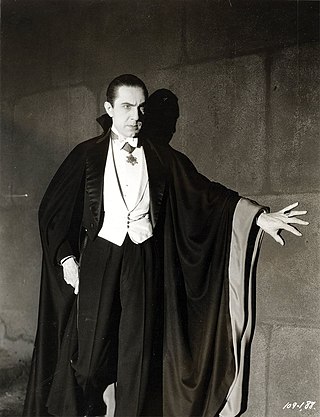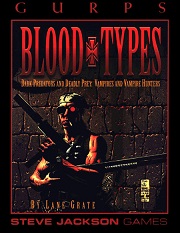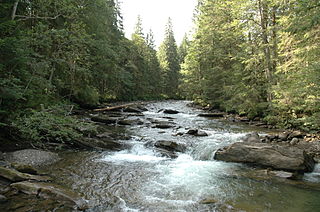
The undead are beings in mythology, legend, or fiction that are deceased but behave as if alive. Most commonly the term refers to corporeal forms of formerly alive humans, such as mummies, vampires, and zombies, which have been reanimated by supernatural means, technology, or disease. In some cases, the term also includes incorporeal forms of the dead, such as ghosts.

A vampire is a mythical creature that subsists by feeding on the vital essence of the living. In European folklore, vampires are undead creatures that often visited loved ones and caused mischief or deaths in the neighbourhoods which they inhabited while they were alive. They wore shrouds and were often described as bloated and of ruddy or dark countenance, markedly different from today's gaunt, pale vampire which dates from the early 19th century. Vampiric entities have been recorded in cultures around the world; the term vampire was popularized in Western Europe after reports of an 18th-century mass hysteria of a pre-existing folk belief in Southeastern and Eastern Europe that in some cases resulted in corpses being staked and people being accused of vampirism. Local variants in Southeastern Europe were also known by different names, such as shtriga in Albania, vrykolakas in Greece and strigoi in Romania, cognate to Italian 'Strega', meaning Witch.

Vampire literature covers the spectrum of literary work concerned principally with the subject of vampires. The literary vampire first appeared in 18th-century poetry, before becoming one of the stock figures of gothic fiction with the publication of Polidori's The Vampyre (1819), which was inspired by the life and legend of Lord Byron. Later influential works include the penny dreadful Varney the Vampire (1847); Sheridan Le Fanu's tale of a lesbian vampire, Carmilla (1872), and the most well known: Bram Stoker's Dracula (1897). Some authors created a more "sympathetic vampire", with Varney being the first, and more recent examples such as Moto Hagio's series The Poe Clan (1972-1976) and Anne Rice's novel Interview with the Vampire (1976) proving influential.

Strzyga is usually a female demon in Slavic mythology, which stems from the mythological Strix of Ancient Rome and Ancient Greece. The demon is similar to a vampire, and is predominantly found in Polish and Silesian folklore.

The strix, in the mythology of classical antiquity, was a bird of ill omen, the product of metamorphosis, that fed on human flesh and blood. It also referred to witches and related malevolent folkloric beings.
A vrykolakas, also called vorvolakas or vourdoulakas, is a harmful undead creature in Greek folklore. It shares similarities with numerous other legendary creatures, but is generally equated with the vampire of the folklore of the neighbouring Slavic countries. While the two are very similar, a vrykolakas eats flesh, particularly livers, rather than drinking blood, which combined with other factors such as its appearance bring it more in line with the modern concept of a zombie or ghoul.
The names of Moldavia and Moldova originate from the historical state of Moldavia, which at its greatest extent included eastern Romania, Moldova, and parts of south-western and western Ukraine.
A moroi is a type of vampire or ghost in Romanian folklore. A female moroi is called a moroaică. In some versions, a moroi is a phantom of a dead person which leaves the grave to draw energy from the living.

Vampires are frequently represented in popular culture across various forms of media, including appearances in ballet, films, literature, music, opera, theatre, paintings, and video games.

Count Dracula is the title character of Bram Stoker's 1897 gothic horror novel Dracula. He is considered the prototypical and archetypal vampire in subsequent works of fiction. Aspects of the character are believed by some to have been inspired by the 15th-century Wallachian prince Vlad the Impaler, who was also known as Vlad Dracula, and by Sir Henry Irving, an actor for whom Stoker was a personal assistant.

Dracula II: Ascension is a 2003 direct-to-video American-Romanian vampire film, directed by Patrick Lussier. It stars Jason Scott Lee, Stephen Billington and Diane Neal. Filmed entirely in Romania by Castel Film Studios, the film is the sequel to Dracula 2000. It was released direct-to-video on June 7, 2003.
Jure Grando Alilović or Giure Grando (1578–1656) was a villager from the region of Istria who may have been the first real person described as a vampire in historical records. He was referred to as a štrigon, a local word for something resembling a vampire and a warlock. He was a stonemason and his wife Ivana bore him two children, Ana and Nikola.

GURPS Blood Types (ISBN 1-55634-113-X) is a 128-page soft-bound book compiled by Lane Grate and published in 1995 by Steve Jackson Games as a supplement for the third edition GURPS role-playing game system. It contains biographies and gaming statistics for 23 vampires, vampire-like beings, and guidelines on creating more for various campaign settings.

The folklore of Romania is the collection of traditions of the Romanians. A feature of Romanian culture is the special relationship between folklore and the learned culture, determined by two factors. First, the rural character of the Romanian communities resulted in an exceptionally vital and creative traditional culture. Folk creations were the main literary genre until the 18th century. They were both a source of inspiration for cultivated creators and a structural model. Second, for a long time learned culture was governed by official and social commands and developed around courts of princes and boyars, as well as in monasteries.

Legends of vampires have existed for millennia; cultures such as the Mesopotamians, Hebrews, ancient Greeks, and Romans had tales of demonic entities and blood-drinking spirits which are considered precursors to modern vampires. Despite the occurrence of vampire-like creatures in these ancient civilizations, the folklore for the entity known today as the vampire originates almost exclusively from early 18th-century Central Europe, particularly Transylvania as verbal traditions of many ethnic groups of the region were recorded and published. In most cases, vampires are revenants of evil beings, suicide victims, or witches, but can also be created by a malevolent spirit possessing a corpse or a living person being bitten by a vampire themselves. Belief in such legends became so rife that in some areas it caused mass hysteria and even public executions of people believed to be vampires.

The Prut is a 953 km (592 mi) long river in Eastern Europe. It is a left tributary of the Danube. Part of its course forms Romania's border with Moldova and Ukraine.
The use of impalement in myth, art, and literature includes mythical representations of it as a method of execution and other uses in paintings, sculptures, and the like, folklore and other tales in which impalement is related to magical or supernatural properties, and the use of simulated impalement for the purposes of entertainment.

Vampironica is an American comic book miniseries published by Archie Horror, an imprint of Archie Comics, beginning in 2018. The story, which takes place outside of the main Archie Comics continuity, focuses on Veronica Lodge as she navigates life after becoming a vampiress. It is written by Greg and Meg Smallwood, with the former also serving as an artist.

Upiór (Tatar language: Убыр , Turkish: Ubır, Obur, Obır, is a demonic being from Slavic and Turkic folklore, a prototype of the vampire. It is suggested that the ubır belief spread across the Eurasian steppes through the migrations of the Kipchak-Cuman people, after having its origins in the regions surrounding the Volga River and the Pontic steppes. The modern word "vampire" derives from the Old Slavic language and Turkic form онпыр , with the addition of the sound "v" before a large nasal vowel, characteristic of Old Bulgarian, as evidenced by the traditional Bulgarian form впир.














